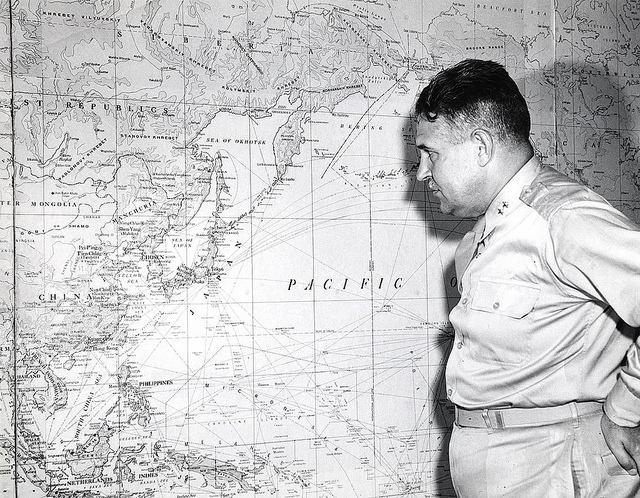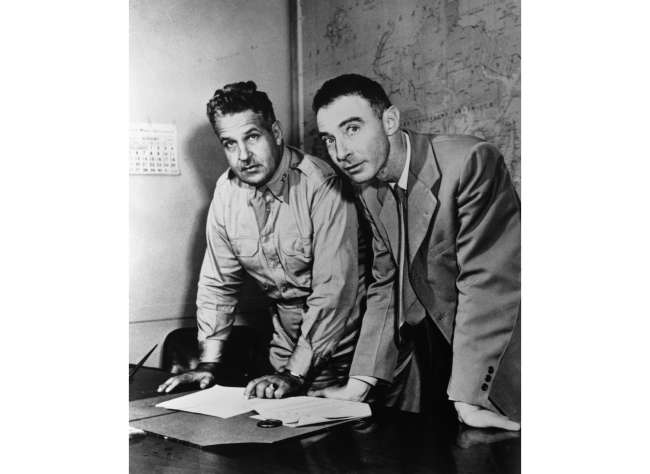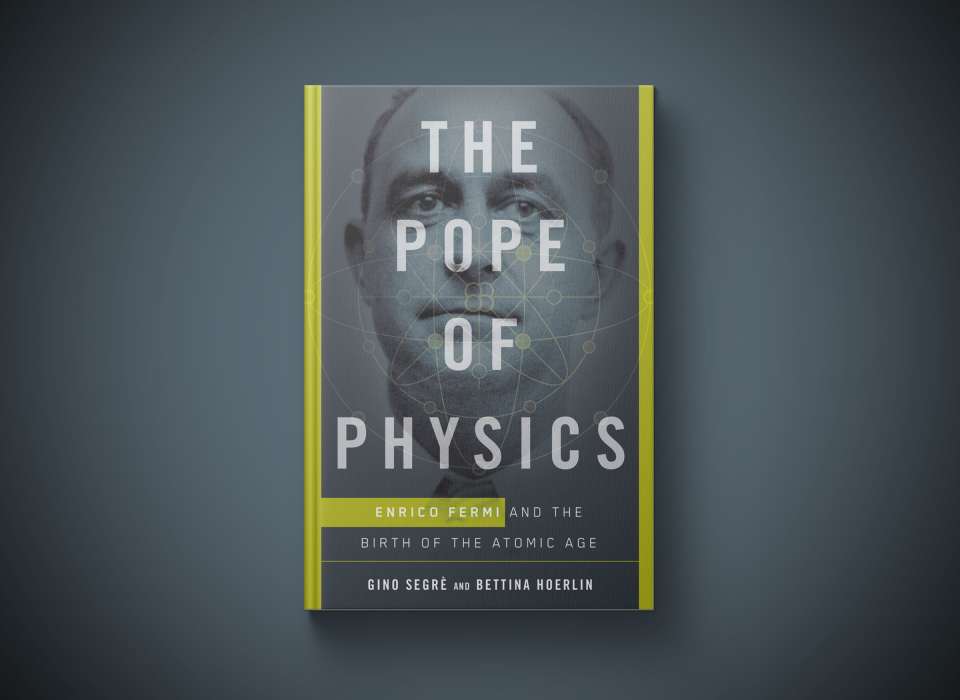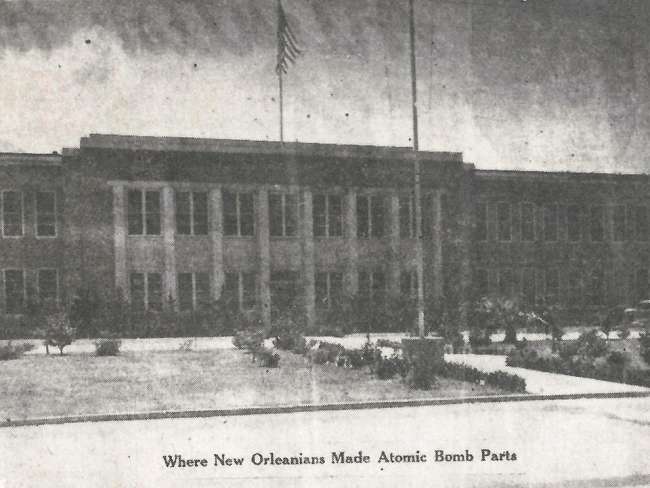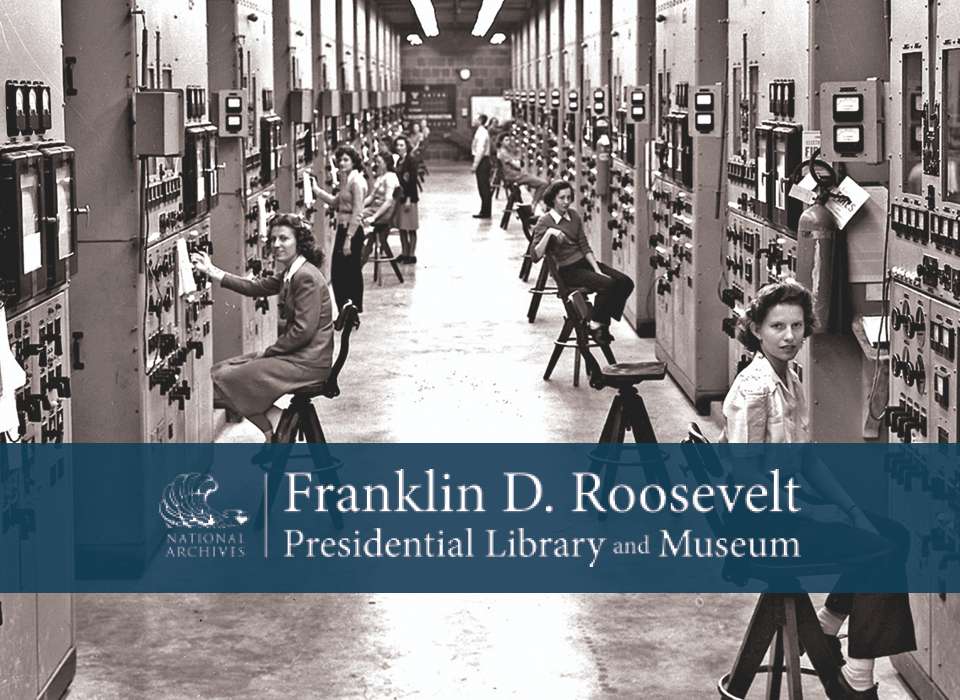Listen: YouTube, Apple Podcasts, or Spotify.
About the Episode
In this special season of World War II On Topic, The National WWII Museum will explore J. Robert Oppenheimer, the Manhattan Project, and the history and ramifications of the atomic bomb.
In this episode, we take a closer look at Lieutenant General Leslie Groves, director of the Manhattan Project. While a lot of interest is rightfully set on Oppenheimer, Groves proves to be an interesting character and pivotal player in the development of the bomb.
During the Museum’s 2015 International Conference, Dr. Robert Norris, author of Racing for the Bomb: General Leslie R. Groves, the Manhattan Project’s Indispensable Man, spoke about Groves and his role in the Manhattan Project. The lecture featured in this episode was edited for length, but the entire session, also featuring author Richard Frank and host Dr. Conrad Crane, can be seen here:
Topics Covered in this Episode
- The Manhattan Project
- Robert Oppenheimer
- The Pacific theater of operations
- Nuclear weapons
Featured Historians & Guests
Robert Norris, PhD
Robert Norris is on the Board of Directors of the Atomic Heritage Foundation. He is the author of a biography about General Leslie Groves, Racing for the Bomb: General Leslie R. Groves, the Manhattan Project’s Indispensable Man, and co-author of Making the Russian Bomb: From Stalin to Yeltsin.
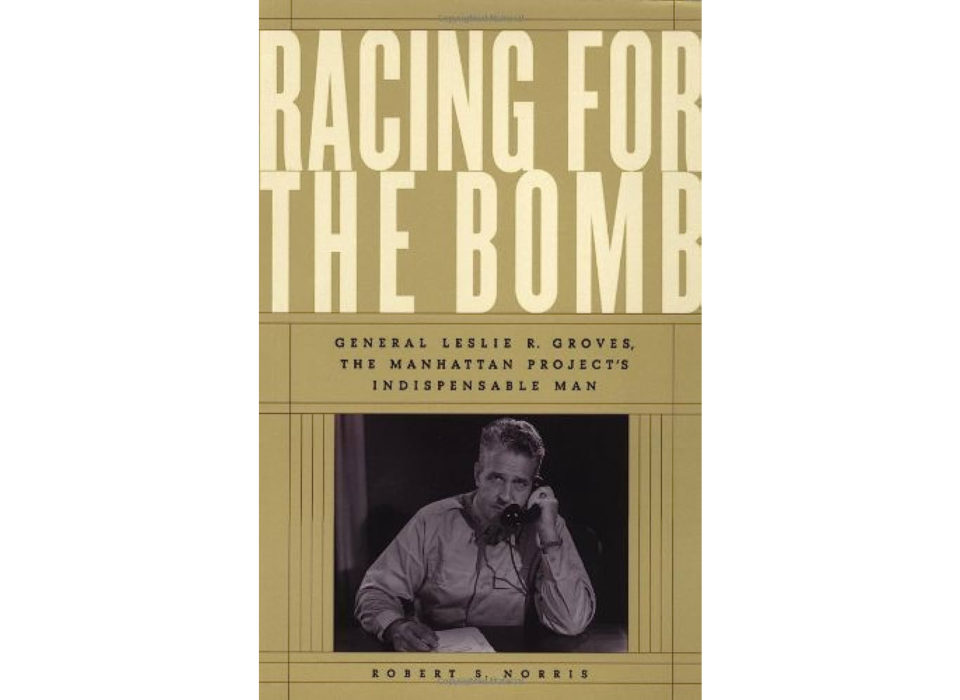
Related Content
-
Article Type
Making Public What Was Once Secret: Los Alamos and The Manhattan Project
Los Alamos and other Manhattan Project Sites developed across the US in 1942 and 1943.
-
The Pope of Physics: Enrico Fermi and the Manhattan Project
75 years after the dropping of the two atomic bombs, join us for a conversation with Gino Segrè, PhD, and Bettina Hoerlin, PhD, biographers of one of the most critical scientists involved in the Manhattan Project.
-
Article Type
Louisiana Spotlight: Mystery at Michoud, Higgins Industries and the Manhattan Project
Higgins Industries is best known for the design and construction of landing craft, dubbed “the boats that won the war,” but the multi-faceted company also contributed to the most top-secret program of the war, the Manhattan Project.
-
Franklin D. Roosevelt, Harry Truman, and the Manhattan Project
Join President Harry Truman’s grandson, Clifton Truman Daniel, and Franklin D. Roosevelt Presidential Library and Museum Director Paul Sparrow for this special event discussing America’s two WWII presidents and their role in the Manhattan Project’s dramatic race for atomic power.
Sponsors
World War II On Topic is made possible by The Herzstein Foundation.
Transcript
Jeremy Collins
Hello, I'm Jeremy Collins from the Jenny Craig Institute for the Study of War and Democracy at The National WWII Museum in New Orleans. Christopher Nolan's new film, Oppenheimer, based on the Pulitzer Prize-winning biography, American Prometheus, co-authored by Kai Bird and Martin J. Sherwin, follows Robert Oppenheimer and his team as they develop the first atomic bomb.
Oppenheimer Trailer
We've got one hope. All America's industrial might and scientific innovation connected here, secret laboratory. Keep everyone there until it's done.
Jeremy Collins
In this special season of World War II On Topic, we will talk about the film in depth with our historians, and also discuss the ramifications and legacy of the bomb. But in today's episode, we take a closer look at Lieutenant General Leslie Groves, portrayed by Matt Damon in Nolan's adaptation. While a lot of interest is rightfully set on Oppenheimer, Groves proves to be an interesting character and pivotal player in the Manhattan Project.
During the Museum's 2015 International Conference on World War II, Dr. Robert Norris, author of Racing for the Bomb: General Leslie R. Groves, the Manhattan Project's Indispensable Man, spoke about Groves and his role in the Manhattan Project. This episode is edited. The whole session saw Dr. Norris joined by author Richard Frank, and the session chair, Dr. Conrad Crane. As an expert on nuclear weapons. Dr. Norris also takes a couple of questions from the audience on where we stand in modern times with these powerful weapons.
Robert Norris
Well, thank you very much. As Conrad said, I'm going to look at General Leslie Groves. If you're not familiar with him, I've written a biography of his life, which doubles, really, as an alternate history of the Manhattan Project. I think that most of you who know something about the Manhattan Project, the historiography has been towards the scientists, they've been center stage, Oppenheimer, Los Alamos, they're the heroes, and Groves got pushed off to the wings of the stage. And what I thought I would do is put him back center stage where I think he was, and my book is following him through this enormous effort.
And we'll start at the beginning here. I sometimes have difficulty envisioning Groves as a baby, but he was born in August of 1896. His father just had joined the Army as a chaplain; he was a minister before that. So he was born in Albany, New York, his father was a minister, and his father joins the Army and becomes a chaplain, and thus young Leslie really grows up in the Army. He's on Army bases here and there as his father gets presented, and he decides that he wants to be in the Army, and the best way to do that is to go to West Point and become a graduate and be an officer.
Now, I learned a lot, in many different respects, and one thing about West Point, 100 years ago, it was very, very difficult to get in. And many of the people who did get in had already gone to college for maybe one year or two years, or sometimes four years. And Groves himself failed a couple of times beforehand, failed the test, and he went to the University of Washington for one year, and to MIT for about two years, before he got into West Point. So he was originally in the class of 1920, graduated early because of the pressure of World War I, so he became the class of November 1918. They pushed these classes through very quickly, and he ended up fourth in his class. I'm sure if he had gone four years, he would've been number one. I would've bet anything on it; he took it very seriously. And if you were near the top of your class at West Point, the almost automatic thing to do was to join the Army Corps of Engineers, which he did.
West Point was founded as an engineering school, and for most of its history, has been a very, very strong contributor to the nation's engineering projects. And Groves chose, as his branch, the engineers. And he's given assignments through the interwar period. He graduates as a Second Lieutenant, and it's a very, very slow process to go through the ’20s and the ’30s for any kind of advancement. He's given bigger and bigger things, he has many different assignments, he gets very good efficiency reports. He gets married, he has two kids. One of his assignments is in Nicaragua.
And as we get closer and closer to what appears to be an inevitable situation of the United States going to war again with Germany, he is given assignments to build depots, munitions plants, Army camps, airfields, you name it. At one point, he has a million people under him. He's the deputy chief of construction for the Corps of Engineers, and he's working on simultaneously 100 projects. One of the projects, and if you know anything else about Groves, it's often mentioned that he built the Pentagon, which he did with his pinky—I swear, he got it done in 16 months under budget—but that was just one of 100 things he's doing at the same time.
On September 17, 1942, Groves was given the assignment of building the (atomic) bomb. Previously, there had been another person chosen by the Army to head the Manhattan Project. The fellow in the middle, Vannevar Bush, and the guy on the right, James Conant, are basically (President Franklin Delano Roosevelt’s) science advisers, and it's Bush that's really pushing, "We got to move faster here." He's worried about the Germans, he's heard about what the British are up to, and he pushes George Marshall, chief of staff, to assign somebody to build a bomb. And they choose a guy named James Marshall (no relation to George). And he's another Corps of Engineers, West Point (graduate), class ahead of Leslie Groves. And Leslie Groves is basically his boss within the Corps of Engineers, so he's looking over the shoulder at what Marshall is doing or not doing. And finally, Bush says, "We got to move faster, we need somebody else." And he goes to Marshall and he goes to Somervell, and then basically says, "Give us your best man." And the best man happens to be Leslie Groves.
I have a sentence in the book that the secret to finding a place in history is being at the right place at the right time, but you don't get there by accident. So Groves really becomes, I think, the indispensable man. Other people could have done it; this guy, Somervell, could have done it. I think the secret to the whole business is the Corps of Engineers. The mentality of these people is such that no project is too big. They take it on, they salute, and we're off to the races, and that's what exactly happened on September 17 when Groves makes enormous decisions in the first few days.
Now, I wondered before how he was able to do all of this, and he's looking over Marshall's shoulder. His two bosses are basically Chief of Staff Marshall and Secretary of War (Henry) Stimson. They've got a million responsibilities, each of them, and they delegate this to Groves, and tell him, "Go for it, as fast as you can." And in the first few days, Groves buys, or takes over, Oak Ridge, Tennessee, and this is where the center of the Manhattan Project starts out. It's going to be the place of uranium enrichment.
There's a great story, it's probably true, it has to be true. FDR is told this program is probably going to cost hundreds of millions, or maybe a billion dollars, so he has the senator from Tennessee, (Kenneth) McKellar, come into the office and he says to McKellar, "Senator, you think, and it has to be secret, you think you can help me hide about a billion-dollar secret project?"
And McKellar says, "Absolutely, Mr. President. Where in Tennessee would you like me to put it?" It's got to be a true story.
Anyway, Oak Ridge becomes a gigantic facility, 56,000 acres, which are taken over by the Army, and that's where the uranium enrichment takes place for what will become the Little Boy bomb. They discover this other element, plutonium, and they discover that it can be also a good fuel for a bomb. And they have another site, chosen by Groves, in Hanford, Washington, and all of these things are just monumental and enormous and huge. Now, I think that the overall cost in 1945 dollars is about $2.2 billion, that's how much the Manhattan Project cost, transferred into today's dollars, maybe between $30 and $40 billion. So it's pretty expensive, but it's not astronomical.
So anyway, Groves has an open checkbook, and his attitude is, "Well, if I duplicate, triplicate, two or three things at the same time, trying to get to the same goal, one of them's got to work." And they all worked. He chooses Oak Ridge, he chooses Hanford, and he chooses, with Robert Oppenheimer, the place where the laboratory's going to be, and that's on a mesa in New Mexico, known as Los Alamos. They take over this ranch school after looking things over in the southwest, and it becomes the place where the scientists, many of them, come, not sure what they're working on, but Oppenheimer is a very effective recruiter.
Groves chooses all of the important people. Oppenheimer is the classic case. Nobody thought Oppenheimer could... One guy said, "He can't run a hamburger stand." He's never done any administrative task, other than running a graduate seminar, but Groves sees something in him that he sticks by him. So this is a quality that Groves had again and again and again. He could size you up in five minutes and know whether or not you could do the job or not, and the best case is Oppenheimer. And he went against everybody; he had absolute power and chose what became a very effective leader at Los Alamos.
Of course, Oppenheimer wasn't alone, and they recruited dozens and dozens of other scientists, many of whom had already won Nobel Prizes, and there were more than one Nobel Prizes after the war, so the level of scientists was very high and was meant to be. The initial concern from Albert Einstein in those early years, 1939, 1940, and it really became an obsession with General Groves, was: "What are the Germans up to? They've got some of the best scientists in the world. They've got this guy, Heisenberg." And so, this plagued them forever here, until they finally intervened into the invasion of, after D-Day, had a special team called Alsos, which was scientists in the military, tracking down the scientists and finding out, actually the German bomb program, there wasn't much to it. And finally, they relaxed. This is at the end of 1944.
One of the reasons that all of these people went into the program to begin with was the fear of a German bomb. What if Hitler got the bomb? There's some colorful characters here. The most colorful perhaps is Moe Berg, here in his baseball uniform. He joins OSS and is given the assignment of assassinating Heisenberg. Didn't happen, but he's in the audience with a pistol in his pocket and cyanide tablets and the other one, and is told that if Heisenberg says anything about the atomic bomb, get up in the audience and shoot him dead and then take the cyanide pill. So Moe does this, but doesn't assassinate Heisenberg, and comes back.
But this is the level that we're talking about here. “How can we stop the German program? We don't know anything about it, but maybe we're going to have to kill some scientists, we're going to have to bomb their laboratories, and we're going to have to, at the end of the war, round them up and capture them,” which they did. And they put these, just to finish that story, they put these German scientists who headed this small-scale program, Heisenberg and others, in a country house in England called Farm Hall. Of course, Groves had the place bugged, and they listened to the conversations of the Germans.
Now, I only bring this up because it remains a contentious issue. Did the Germans know how to build a bomb or not? And there's big literature on either side of this. The German scientists themselves claimed, falsely, I believe, they did know how to make a bomb, but they didn't want to tell Hitler because they thought, “He's a madman and we can't contribute to that.” I think that's baloney, but anyway, that was the German argument soon after they were captured. And I think the real answer is they overlooked some things. As smart as they were, Heisenberg, they didn't know how to make a bomb. And when they hear, over the radio, on August 6, 1945, that the United States has dropped a bomb on Hiroshima, Heisenberg realizes that you only need this much highly enriched uranium, you don't need tons of the stuff, so he miscalculated, and basically, I think, did not know how to make a bomb.
The United States went forward, and as Conrad said, we pursued two different types of bombs. One was a uranium bomb, highly enriched uranium, which came from the uranium enrichment facilities at Oak Ridge, that was dropped on the Japanese. And at the same time, which I really find remarkable, almost on the same day, there's enough material for the two different types of bombs. And the plutonium bomb, they're less sure that it's going to work, so they have to have a test, and that becomes the test at so-called Trinity on July 16, 1945.
And Groves is always anticipating what the next step is. He contacts the Army Air Forces and convenes what becomes the 509th Composite Group with Paul Tibbets in overall charge. And on the one hand, the first bomb is dropped by his plane, the Enola Gay. And then, three days later, on August 9, 1945, the second bomb, the plutonium bomb, is dropped on Nagasaki, in a plane called Boxcar.
The Little Boy, (dropped over Hiroshima, was) basically a gun assembly where you take a piece of highly enriched uranium and shoot it down into another piece and it blows up. They didn't need to test it, they knew it was going to work, and of course, it did.
The Fat Man, (dropped over Nagasaki, was) a five-ton behemoth that they have a little ball of six kilograms of plutonium inside of it, and rather than banging one piece of plutonium into another, which they found out won't work, we're going to have to have another design to compress this ball of plutonium inside that Fat Man, and then it will blow up. And of course, it did.
And so, August 6 and August 9 are the two days of the bombings of Japan. A couple of days later, we have the end of the war. There's devastation at Hiroshima and Nagasaki; Groves sends teams to find out what happened.
And after the war, he's basically pushed out the door and writes his own book, Now It Can Be Told, in 1962. (He) enjoys his children and grandchildren. I should say that one of his grandchildren lives here in New Orleans. And in July 1970, he has a heart attack at a local country club, drops dead. He's buried in Arlington Cemetery, and then his wife lives out a bit longer.
So that's a very abbreviated view of General Groves, we can go into some more. My view on the decision to use the bomb by saying that there was no decision. There is not one scrap of paper in the Truman Library archives that says, "I, Harry Truman, authorize the use of the atomic bomb on Japan." It's not there, period. Truman, he's the accidental president, he becomes president in April 1945; the Manhattan Project, under Groves' control and direction and focus, is a runaway train. There is so much momentum built up, that it's inevitable that this bomb is going to get used, come hell or high water. And the only thing that Truman could have ever done was to say no, and he wasn't going to say no to people like George Marshall or Henry Stimson, two figures that he has the utmost regard for. So after the war, Truman interjects himself falsely by writing a memoir that has him doing more than he ever did, and he has become the focus of a great deal of this historiography.
Dr. Crane
Now, I know there's a lot of questions out there. Let's start it off.
Audience 1
Mr. Norris, you said that the Manhattan Project costs $30 to $40 billion in today's dollars. You described that as expensive, but not astronomical. I think you missed your calling, you should run for Congress. I have read that the United States has built over 70,000 nuclear weapons. Can you comment on that number, and the number that still exists around today, in all the countries of the world? And also the broken arrows, I think there's about 12 of them that we have lost and not recovered, or something in that neighborhood.
Robert Norris
Well, on my day job, I follow this rather closely, and that 70,000, I've modified it slightly. That was my number to begin with, it's now down to about 69,000 or something. But anyway, after the war, the United States went to town and built a nuclear weapon for every conceivable mission. It was the thing to have. And the Army wanted this number, and the Air Force wanted this, and the Navy wasn't going to be left out, so there was an enormous competition among the services for every conceivable type of nuclear weapon, which we went ahead and built, all within the context of, the Russians are coming, they're doing the same thing, the Americans are coming. So we have a very intense arms race, which peaked in the late ’60s for us, we had more than 32,000 at the same time.
Mercifully, we had arms control treaties, which got things lower and lower, and a host of unilateral actions by the professional military themselves, who said, "These things are too expensive to run. I can use the money somewhere else, and I can have a usable weapon." So the Navy got rid of a whole bunch of stuff, the Army's out of this business, totally, and we're down to a stockpile of about 5,000 right now. And we have, with the Soviet Union and now Russia, a series of treaties and relationships where I think the two of us have handled this problem pretty well. We've both been responsible stewards at making the weapons safe, and you bring up what are called broken arrows, which is the military term for an accident. A certain thing has to happen for it to be an accident, and the United States has had 32 of them, and we know what they are, and there's a good story around each one of them.
But with the shrinking arsenal and less logistic movement and improved safety features in the weapons themselves, it's a much safer arsenal. We've tried to teach the rest of the world, first the Soviets, "You got to do the same thing. You got to make them safe. We don't want any accidents," all kinds of notifications. And I think they did that. But what about the Indians and the Pakistanis? Do you think they're having the same kind of searching investigation of their own weapons about how safe they are? That's scary stuff, and we just don't know what goes on inside of that. So the bomb has spawned all kinds of things, an arms race that was a close call a couple of times, very close call, the Cuban Missile Crisis, the more we look at that, the more we find out new things that almost happened, and we got through it by the skin of our teeth.
But now, we have a host of other problems. We have an environmental legacy that they made a mess. Don't bother me, the Russians are coming. But now, there's the cleanup costs of all of that. And all of these other countries that want nuclear weapons, and thinks that having them will somehow garner them more security, which ultimately they won't. So I don't know, maybe that answers your question a little bit.
So just one quick comment. To use the word, "Decision," there's something to matter with that word, and the historiography of this whole issue has revolved around this word, "Decision." Decision means a collaborative discussion, weighing the pros and cons. None of that happened. None of that happened at all. So even to use the word decision is a misnomer. And as I said before, there was no decision, basically. There was all of this momentum generated by building the bomb itself. A lot of people's careers were tied up in all of this, and they saw that it could be the winning weapon and so on and so forth. So it would've been a searching, what a decision really is, a weighing of this and that and the other thing, and coming to some conclusion. None of that happened. None of that happened at all.
Audience 2
This is for Dr. Crane. You mentioned that President Truman did not make any decision regarding the use of the atomic bomb. If you look at Potsdam Conference, that's when he was informed the Trinity test results were better than expected. And he wrote on a small piece of paper, basically, in a coded form, saying that when Manhattan drops on Japan, it will [inaudible]. And he also advised the high command to wait until the Potsdam is finished before the first bomb is dropped. So I would argue that that indeed was a decision, by the President of the United States, to make use of the bomb implicitly.
Dr. Crane
Well, I can't disagree with that interpretation, but that was the way everybody was going. It was easy to ride the rail with everybody else. It was much harder to turn around and say, "Don't use it." So you can interpret it that way that he decided to agree with everybody else, but again, I think the decision was he just accepted a decision that had already been made.
Robert Norris
The actual order to the South Pacific Forces was done on July 25, with the signature of General Handy, who was the deputy chief of staff. Marshall was in Europe. And the phraseology, or the phrase that was used in there, by General Groves, of course, was basically what came to be known as pre-delegation. "Keep using the bombs as made ready." As made ready. As soon as you have one, boom, keep going. Truman finally, finally, interjected himself into that and stopped the pre-delegation order, but they would've been continually used until told not to. And the next bomb was ready in August 17, probably, Groves tells Marshall, and Groves, being a good officer here, has them lined up all the way to Christmas, one every 10 days. Because now, plutonium is pouring out of Hanford, and he knows how much is needed, and he can determine a schedule that will have a bomb ready every 10 days or so, three a month as long as you want. And two do the trick, but the third one is ready, and the cruiser ready. He's got his own Air Force ready to go.
And Truman who's out in the middle of the Atlantic when the bomb goes off, the first bomb goes off in Hiroshima, and he's still a neophyte in terms of all these responsibilities, and shame on FDR for only telling him nothing, for a whole host of issues, and then dropping dead and leaving Truman alone with all of these responsibilities. And he grew into the job and has become viewed as a very effective president. But these first few months, he's adrift and he knows it. And he's got to rely on people who know a lot more than he does, people like Marshall, people like Stimson. And he finds out about this runaway train here. And as Conrad said, let's jump aboard and other people's decisions have it going forward, and I'm on board, and the bomb is used.
Museum Host
Ladies and gentlemen, please.
Jeremy Collins
In next week's episode, we will hear from two of our historians, Dr. Jason Dawsey and Dr. John Curatola, on the heels of their viewing of Nolan's Oppenheimer. That discussion releases on Monday, July 31. Visit nationalww2museum.org/podcasts for updated episodes. That is nationalww2museum.org/podcasts. Don't forget to check out the events tab on our homepage at nationalww2museum.org as well, to catch riveting conversations and lectures in real time.
This series is made possible by the Albert and Ethel Herzstein Charitable Foundation, which supports content like this, from The National WWII Museum in New Orleans. Please remember to rate and subscribe. I'm Jeremy Collins, signing off.
